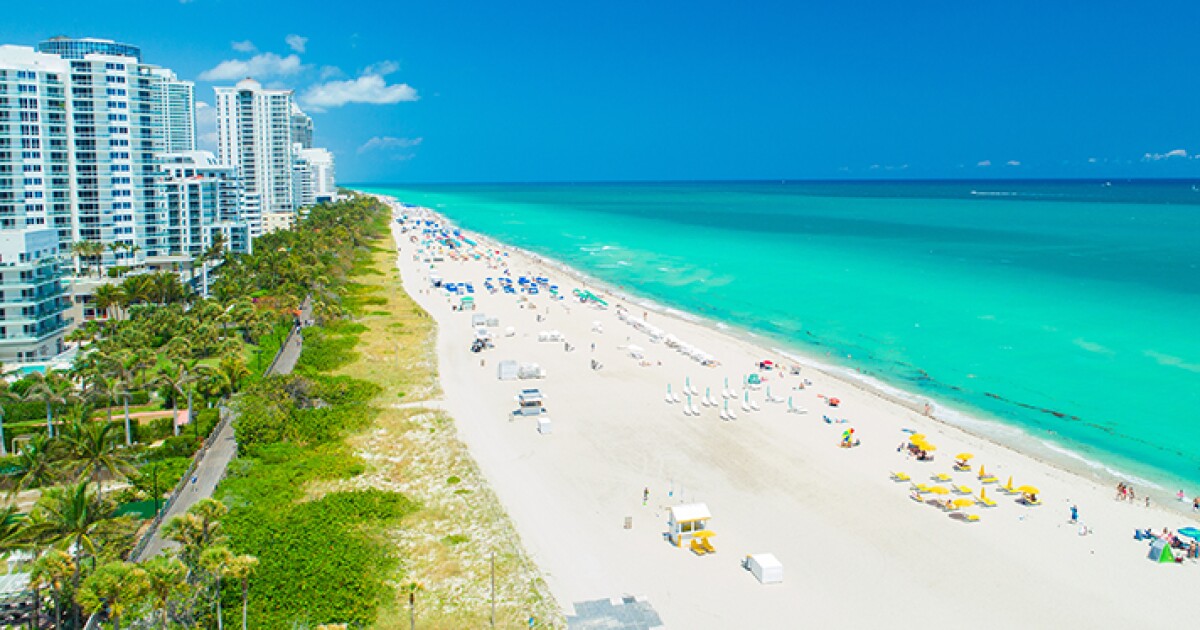Miami Beach outlook turns sunny as tourists return

Miami Beach, Florida, is recovering quickly as the COVID-19 pandemic recedes and tourists — along with their revenue — make a return to this coastal beach town.
S&P Global Ratings revised the outlook to stable from negative and affirmed the AA-minus rating on the city’s Series 2015 resort tax revenue bonds. The revision, S&P said, reflects the rebound in pledged revenues as the pandemic’s impact on the city lessens and it returns to a more normal pace.
Adobe Stock
“We are excited to see that the city of Miami Beach is experiencing a robust post-COVID recovery,” John Woodruff, chief financial officer of the city’s Finance Department, told The Bond Buyer. “The city has recently collected the highest resort tax revenues in its history and property values are poised to increase significantly from a red-hot real estate market.”
The rise in real estate prices in the city continues a years-long trend.
In February, the median home price listing in the city was $575,000, up 5.3% year-over-year, according to Realtor.com. The median price of homes sold was $480,000.
The city’s fiscal 2021 draft audit shows a 93% revenue recovery relative to the highs seen in 2019 and pledged revenue has exceeded 2019 levels in each of the first several months of the fiscal year for which reporting was available.
“We expect pledged revenues will continue to meet or exceed 2019 levels in the short term, leading to rating stability,” S&P said.
S&P said the city’s AA-minus rating reflects both the strength and the stability of pledged revenues and the general creditworthiness of Miami Beach.
The Series 2015 bonds are secured by a first lien on resort tax revenue. This consists of a 4% tax on hotel rentals and other short-term accommodations and a 2% tax on food or drink sold at restaurants. These taxes don’t sunset and are senior in terms of debt service for these bonds.
S&P noted the resort tax is the maximum allowable under state law. Originally 3%, the additional 1% levy was authorized by city voters in 2012 and can only be used to finance convention center projects and related debt service, while the balance of the 4% tax can be used for a variety of purposes centered on tourism.
Resort taxes are collected across Miami Beach and remitted directly to the city.
Miami Beach is a resort city located in Miami-Dade County and rests on natural and man-made barrier islands lying between the Atlantic Ocean and Biscayne Bay, which separates it from the city of Miami. It is the state’s 26th largest city with a population of about 83,000.
Miami-Dade County saw roughly 1.2 million coronavirus cases since the pandemic began in 2020, leaving more than 10,000 people dead.
S&P revised its outlook in May 2020 on the Series 2015 bonds to negative from stable due to the revenue uncertainty stemming from the pandemic.
Audited pledged revenues from fiscal years 2019 to 2020 plunged by 37%, from $88.2 million to $55 million, resulting in maximum annual debt service coverage falling to 4.41 times from 7.09 times.
“Based on the draft fiscal 2021 audit, we expect coverage to improve to approximately 6.6 times, given pledged revenue improving to approximately $82.2 million,” S&P said. “Additionally, revenues exceeded 2019 collections in the first five months of the current fiscal year, and we expect collections will likely remain at least at 2019 levels.
“Consequently, we expect coverage to remain significantly stronger than 2020. We do not expect to revise the rating during the two-year outlook period,” S&P said.
S&P said its ratings reflect:
- A strong-to-very strong economy, including the Miami-Fort Lauderdale-West Palm Beach metropolitan statistical area, which it considers broad and diverse;
- Moderate volatility of tourist development tax revenues; and
- Strong coverage and liquidity profile, with coverage expected to remain significantly above the 1.5 times additional bonds test.
“We view this rating action as a direct result of improving health and safety conditions, a social factor under our environmental, social, and governance considerations,” S&P said.
The agency said the city’s governance and social risks related to economy, management, financial measures and its debt and liability profile are in line with the sector standard.
Still, the rating agency said environmental risks are elevated for the city, especially from hurricane winds and flooding, which could be the largest danger to Miami Beach over the long-term.
Since 2011, the city issued about $933 million of debt with the most occurring in 2015 when it sold $353 million of bonds.
The Miami Beach Redevelopment Agency has sold about $322 million of bonds since 2011 while the Miami Beach Health Facilities Authority has sold about $446 million of debt.
Mayor Dan Gelber said in his state of the city address on March 7, “the state of our city is strong, very strong and only getting stronger.”
The pandemic was especially difficult for Miami Beach, he noted, because the city wasn’t built for social distancing.
“Our entire economy, the ethos of our city is all about sharing our experiences in person,” Gelber said. “Our hotels and restaurants, our bars, our cultural venues are all focused on putting lots of people together, often in confined spaces.”
Until March 2020, he added, this was a “wildly successful business model.”
However, COVID forced the city to navigate the tension between protecting lives and preserving livelihoods, but the city remained resilient.
“We’ve emerged financially strong,” Gelber said. “We ended our last fiscal year with a $12 million surplus, which helped increase our reserves that are now at levels higher than were pre-pandemic.”
He added the city remains on a steady course.
“The last financial analysis projects that we will end this fiscal year with a $5 million surplus in the general fund and a $6.5 million surplus in resort taxes. Thank you to CFO John Woodruff and his staff for fiscal stewardship.”
The city’s resort taxes so far this fiscal year, which began in October, were not just the highest for the same period in the past few years, they were the highest in the city’s 100-year history, Gelber said. “People want to be here.”
However, things are not always so sunny in South Beach.
The city imposed a state of emergency which included a midnight curfew and a ban on evening alcohol sales that lasted for several days in late March after two separate shootings took place in the neighborhood that is famous for its rowdy Spring break partying.
Five people were injured in the shootings, but no one was killed.
Officials have been working on measures to avoid problems that have plagued the neighborhood for several years.
Meanwhile, Gelber announced construction began on the Irma and Norma Brayman Cancer Center on the Mount Sinai Medical Center’s Miami Beach campus.
“The Brayman Cancer Center will create needed access to clinical expertise, robust support services, research, trials and newest technologies — all housed in an ultra-modern $250 million facility with views of beautiful Biscayne Bay,” he said.
The 200,000 square foot center is expected to be finished in 2025 and will serve all members of the city’s population. It is affiliated with Columbia University in New York.
Gelber was elected mayor in 2017 and re-elected in 2019 and 2021. He is a former state representative and senator and was elected by his colleagues as Senate Democratic Leader. He is a lawyer and practices with Gelber Schachter & Greenberg PA.


